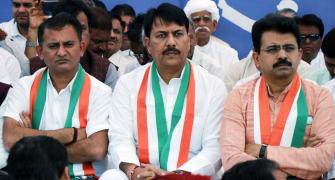Inflation is like a toothache. It grows slowly, inexorably and, in the end, affects your efficiency. Just like for toothaches, tolerance levels vary for inflation. Some countries can tolerate higher levels of it without growth slowing down.
For others, the threshold is lower. Developed countries have lower inflation thresholds -- as usual the rich are softer -- and developing countries have higher thresholds.
But for those charged with the conduct of economic policies, knowing just this much is not enough. They also need to know where the threshold actually lies so that corrective action can be taken in time.
This is not as easy as it sounds because it involves what is basically a political choice of balancing inflation with unemployment. Often the central bank comes into conflict with the government.
Kanhaiya Singh of the National Council for Applied Economic Research (NCAER) and K Kalirajan of the Australian National University thought it would be a good idea to find out what the threshold level for India is.
In a recent paper* in which they jump through a truly mind-boggling number of econometric hoops, they conclude that there is none.
This doesn't mean you can have any level of inflation without slowing down growth. Quite on the contrary -- it means that practically any level of inflation is bad for growth.
The objective of monetary and fiscal policy, therefore, must not just be to keep inflation low, preferably zero like a toothache, but also to keep prices stable.
In other words, going from 3 to 4 per cent inflation in a 12-month period may not sound like a very big deal. But the authors insist that this slows down growth just as going from, say, 4 to 5 per cent or from 5.5 to 6 per cent would.
Or as they put it, "any increase in inflation from the previous period at any level has a negative effect on economic growth". If that is the case, as the econometrics in the paper says it is, it makes the job of the central bank even harder.
That said, zero inflation is neither possible nor desirable, which leads to the vital question: what rate should the authorities target? In 1989, during the run-up to another general election, I asked this question of the senior-most economist in the Prime Minister's Office.
His reply was that inflation targeting was a pie-in-the-sky and that it was only when inflation began to get near 7 per cent that it became a cause for concern. The reason: dearness allowance (DA) payments!
We have come a long way since then and though the increases in DA payments may still be the only trigger for the finance ministry, for the reserve Bank of India (RBI) the bar has moved lower.
So, say Singh and Kalirajan, given that it has to function under very different conditions, the band to be targeted should be between 4 and 7 per cent. One has to infer from what they say earlier in the paper that the movement within this band must be kept slow and steady because both expectations and fiscal policy play a much bigger role in India.
So where do we go from here? Except for 2001-01, inflation between 1997 and 2003 was within the Singh-Kalirajan band, but it was not stable. Growth too fluctuated.
How much of this fluctuation was due to changes in the rate of inflation? This is what Singh and Kalirajan have sought to find out in this paper.
Not all of what they say may be right but, nevertheless, it is something the finance ministry and the RBI should examine carefully as they try and calibrate the fiscal-monetary mix.
If they get it right, there is no reason why growth rates cannot remain in the 6 and 7.5 per cent range for the foreseeable future. But the cleverness will lie in anticipating inflation correctly.
There the RBI might be getting things a bit wrong now. It thinks the average inflation rate for this year will be 4.5 per cent. But in order to get there, the inflation during the last quarter will have to be around 2 per cent.
Will it? We will find out soon enough.
* The Inflation-Growth Nexus in India: An Empirical Analysis, Journal of Policy Modeling 25 (2003).







